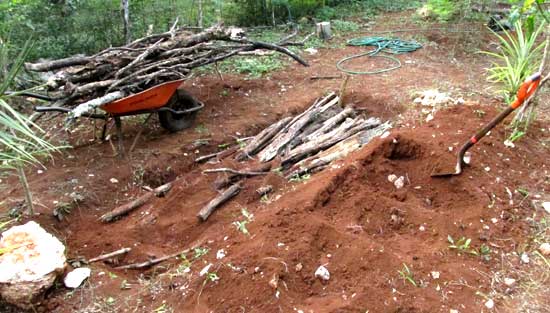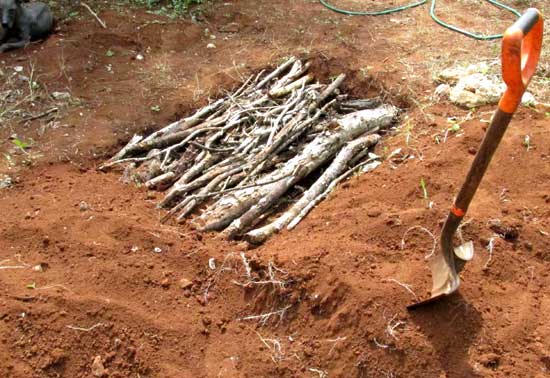Excerpts from Jim Conrad's
Naturalist Newsletter
from the November 6, 2016 Newsletter issued from Rancho Regensis north of Valladolid, Yucatán, MÉXICO
PLANT BED FOR AN ARID CLIMATE I arrived here just as the young engineer Carlos was leaving. One project he left undone consisted of a rectangular pit about 15 inches deep (40cm) with decaying, woody stems lined up next to one another on the pit's bottom, forming a kind of floor. I had to ask what it was for.
"The rotting wood is soft and spongy," I was told. "Once it's covered with dirt and things are planted atop the bed, the wood will hold water for the plants even as the soil all around dries out during the dry season."
That sounded like a good, workable idea to me, so I set about filling the pit with spongy, decaying, woody stems and tree trunks. I'm sure that someplace an expert has worked out how thick the layer of woody stems needs to be, how deep the soil should be piled atop it, and the proper procedure for doing it all, but I didn't have access to that, and just my own intuition on the matter.
The Maya fellows who did the labor for Carlos had made a very neat floor with straight stems of similar size, but many of the poles were bamboo. I didn't use bamboo because those stems are mostly hollow inside, so when the walls eventually decay and collapse, dirt above the bamboo would settle, and I didn't want that. I used regular bush and tree stems, including some leg-thick ones, just so they were so rotten that they were soft and spongy inside. Usually I could force my thumb into a stem, it was so soft.
After fmaking the pit's bottom layer about half a foot deep, I hosed water over the rotten wood, spread a thin layer of dirt atop that, and hosed it down, remembering that the whole idea is to establish a sponge-like reservoir for moisture. Below, you can see the pit at the point when the bottom layer was half covered with dirt, and a wheelbarrow with more wood to add atop that stood at the pit's side:

Below, a close-up of the decomposing wood in the wheelbarrow shows how the stems' bark is flaking off and in places the wood itself is crumbling away:

Then I spread another half-foot layer of pithy, crumbly wood atop that, hosed it down, and spread the remaining dirt that earlier had been shoveled from the pit atop it. Below, you can see what the pit looked like after I'd covered about half the wood:

We have other beds not containing decaying wood, and as our winter garden develops during the dry season, which is beginning about now, it'll be interesting to see if any differences become apparent.